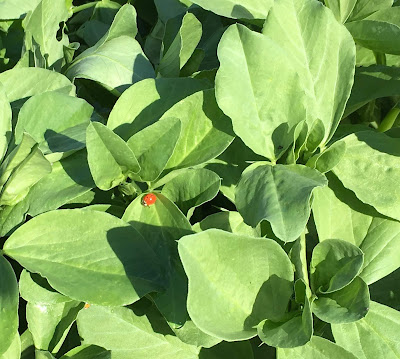
|
|
Growing a cover crop, such as at the Fair Oaks Horticulture Center
l
ast fall, will improve your summer crop-depleted soil. Lady bugs apparently
like it, too. (Photo:
Kathy Morrison)
|
Planting 'green manure' is an easy way to improve your soil over winter
Here are potential reasons for not planting a cover crop in your vegetable garden this fall:
-- You’re incredibly motivated and have already planted every inch of your space in beets, carrots, garlic, onions, lettuce and chard.
-- You’re hanging on to every bit of your summer garden until frost hits, even if that’s not until January.
-- You’ve cleared your veggie area and are looking forward to the weeds taking it over.
-- You have no idea what a cover crop is.
I’ve been guilty of the second reason, so you have my sympathy. (But really, pull out the zucchini, at least.)
Simply put, a cover crop is planted specifically for improving the soil; certain crops attract beneficial insects, as well. A cover crop can be planted in summer or fall. If it's planted in fall and tilled under in early spring, it's also known as "green manure."
I'm not going to get too far into the science on this, but basically a cover crop of legumes -- the peas and beans family -- will add nitrogen in soil that has been depleted by a food crop. You can also grow grasses, such as oats, wheat or ryegrass, to help break up the soil and control erosion. Legumes and grasses both can suppress weeds and add organic matter to the soil. "Soil builder" cover crop mixes usually include some varieties of each.
For home gardeners, the key to cover crops is to cut them down at the right time, in late winter or early spring, then work them into the soil. You have to allow enough time for "green manure" to break down in the soil before you can plant a new producing crop in that spot.
From my experience, for gardeners with small plots or raised beds, it's best to go with the legumes. These stay tender and are easy to cut down. (I grew oats one year and should have used a machete to whack them down; clippers were over-matched.) They also produce flowers that attract pollinators when not much else is blooming.
Examples of legumes to grow include field peas, also known as Austrian winter peas, shown in the photo above; bell beans; annual lupines, including some native varieties; crimson clover and red clover; and various varieties of vetch. Fava beans and garden peas both will produce an edible crop, a bonus, though you will wind up harvesting part of the nitrogen instead of using it to enrich the soil.
One important element to growing legumes: They do much, much better when the seeds are first treated with an inoculent. This is where some of the science comes in. The inoculent includes a specific bacteria that will create nodules on the plants' roots. These nodules are where the nitrogen from the atmosphere is "fixed."
Inoculent has to be fresh, and it has to be the right one for that legume. (It will say on the package.) Local sources I've used for inoculent include
Peaceful Valley Farm and Garden Supply
and some of the local nurseries. Inoculent is light- and heat-sensitive, so needs to be applied to the seeds right before they're planted. Experts recommend using a natural "stickum," such as a bit of corn syrup dissolved in hot water (1 to 9 ratio) or 1 teaspoon of molasses in about 2/3 cup of whole milk, to help the inoculent adhere to the seeds. The planting bed also needs to be kept moist until germination, and watering should continue after germination until the rainy season begins.
Then write yourself a reminder to chop the crop down and dig it into your soil in late February or early March, just about the time we all start thinking about planting our summer veggies. It will be ready to enrich your tomatoes in three to six weeks.

